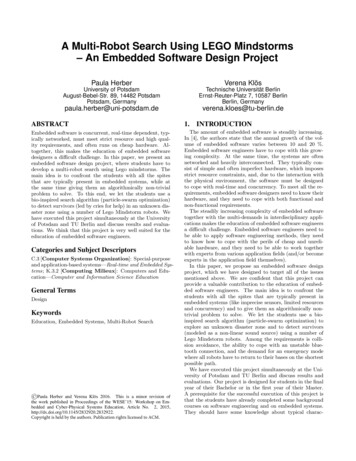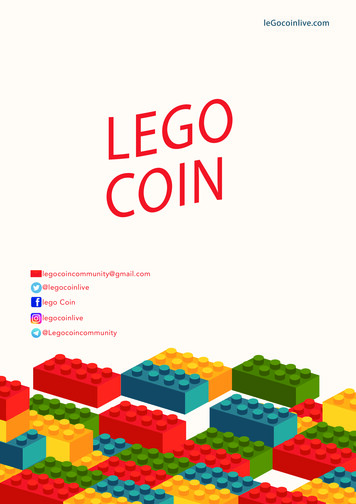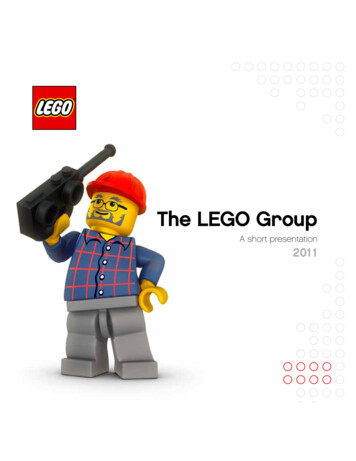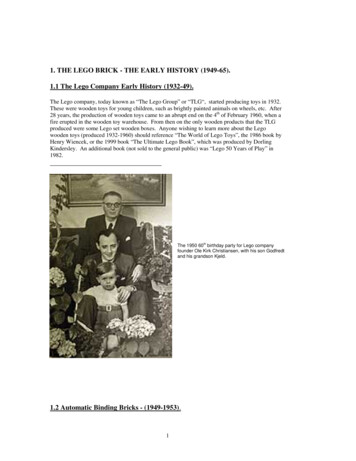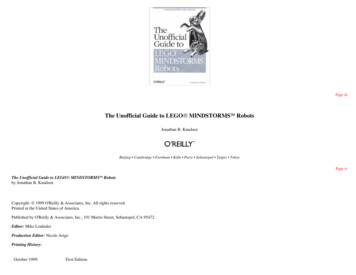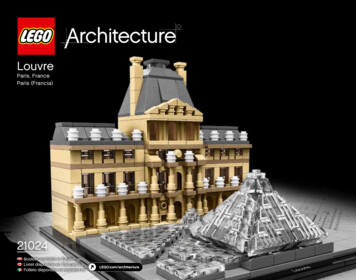
Transcription
LouvreParis, FranceParís (Francia)21024Booklet available in English onLivret disponible en français surFolleto disponible en español en
Musée du Louvre,Dist RMN/ Franck BohbotThe LouvreThe Louvre, in its many different forms, hasdominated the city of Paris since the late 12thcentury. Today it is the most visited museumin the world, renowned for famous works ofart such as da Vinci’s Mona Lisa, as well asthe building’s spectacular Renaissance toModernist architecture.2Pyramide du Louvre: original work of I.M. Pei Musée du Louvre, Dist RMN/ Phodia Musée du Louvre, Dist RMN/ Olivier Ouadah
Pyramide du Louvre: original work of I.M. Pei Musée du Louvre, Dist RMN/ Olivier Ouadah
HistoryFrom Fortress to MuseumWhen Louis XIV moved his royal court from the Louvreto the recently enlarged Palace of Versailles in 1678,much of the royal art collection remained at the Louvre.A number of national cultural institutions and scholarlysocieties moved into the Louvre, which also became aresidence for artists. In 1699, the Académie Royale dePeinture et de Sculpture (Royal Academy of Paintingand Sculpture) held its first public exhibition in thebuilding’s Grande Galerie (Great Gallery).The transformation of the Louvre into the museum weknow today began with the French Revolution. In 1791,the new National Assembly declared that the Louvreshould be “a place for bringing together monuments ofall the sciences and arts.” When Louis XVI was arrestedin 1792, his royal art collection became nationalproperty. The Louvre Museum officially opened a yearlater, giving free public access to a collection that4included works by da Vinci, Raphael, Poussin, andRembrandt.Throughout the next 200 years, the Louvre wouldwitness the restoration and abolishment of the Frenchmonarchy, the Napoleonic era, and the establishmentof five new French Republics. The museum’s collectionincreased throughout this turbulent period, and by theearly 1980s it was clear that a major renovation wasneeded to improve the displays and provide betteramenities for the increasing number of visitors. Musée du Louvre, Dist RMN/ Olivier OuadahThe original Louvre was a fortress built in the late 12thcentury to protect the city of Paris. Located on thewestern edge of the city, the structure was graduallyengulfed as Paris grew. The dark fortress from theMiddle Ages was continuously altered and expandedbefore being transformed into a Renaissance-styleroyal palace from 1546 onwards.
RenovationWhen New met OldThe committee in charge of overseeing the projectvisited museums in Europe and the United States, andits members were particularly impressed with the EastBuilding of the National Gallery of Art in Washington, DC.Its architect, I. M. Pei, was invited to Paris and asked tolead the comprehensive renovation project.The biggest challenge Pei faced was the lack of space.The physical layout of the Louvre had remained the samesince 1874: two wings attached to the oldest museumbuilding, forming a rectangular structure around theCour Napoléon plaza.Pei’s solution was to hollow out the central courtyard,place the main entrance in its center, and constructa series of underground connections to the variouswings. Visitors would descend into a spacious lobbyand quickly access the main Louvre buildings. Pei alsoproposed reorganizing and redistributing the collection,as well as covering several smaller courtyards to createmore display space.However, Pei’s proposal for a glass-and-steel pyramid tocover the new entrance would cause great controversy.To Pei, the shape not only provided the new lobby withthe best natural light, it was “the most compatible withthe architecture of the Louvre.” Many disagreed, withone opponent describing the proposed pyramid as a“gigantic, ruinous gadget.”The criticism eased somewhat after Pei placed a fullsize model of the pyramid in the courtyard. The newentrance, with its famous pyramid, was inaugurated inMarch 1989 and became an instant architectural icon forthe newly renovated Louvre Museum. EPGL. Patrice Astier 1987When President François Mitterrand came into powerin 1981, he launched an ambitious program to createa series of modern architectural monuments in Paristhat would symbolize France’s role in art, politics, andeconomics. The best known of these Grands Projets(Grand Projects) would be the redesign and expansionof the Louvre.5
Pyramide du Louvre: original workof I.M. Pei Musée du Louvre,Dist RMN/ Antoine MongodinThe Louvre Today Musée du Louvre, Dist RMN/ Franck BohbotThe renovation of the Louvre was completedin 1993 and proved a great success: thenumber of visitors to the museum doubledwithin the first year. With an area of 652,300 sq.ft. (60,600 m2) and over 400,000 works of artin its collection, it remains one of the largestand most impressive museums in the world.With close to 10 million visitors each year, theLouvre has also become the world’s mostvisited museum.[ It signifies a break with the architecturaltraditions of the past.It is a work of our time. ]I. M. Pei6
Pyramide du Louvre: original work of I.M. Pei Musée du Louvre, Dist RMN/ Stéphane Olivier
The ArchitectIeoh Ming PeiIeoh Ming Pei was born in China in 1917 and traveled tothe United States at the age of 17 to study architectureat the Massachusetts Institute of Technology (MIT).Inspired by the work of Le Corbusier and the newInternational Style of architecture, he continued toHarvard’s Graduate School of Design, where he metWalter Gropius and Marcel Breuer, two leaders of theEuropean Bauhaus movement.In 1955, after working for the New York firm of Webb &Knapp on a variety of large-scale structures across theUnited States, Pei established his own firm, I. M. Pei andAssociates. Pei and his team worked on a number ofmajor projects, including the Kennedy Library in Boston,Dallas City Hall in Texas, and the new East Building of8Washington DC’s National Gallery of Art. It was this lastbuilding that would bring him to the attention of those incharge of the Louvre renovation project.Pei would be the first foreign architect to work onthe Louvre, and many in France were skeptical thatsuch a prestigious national project had been givento an architect with a reputation as the “master ofmodern architecture.” Pei himself was acutely awarethat “the history of Paris was embedded in the stonesof the Louvre.” Although his suggestions—not leastthe glass pyramid—initially received much criticism,the renovation was a great success and the Louvre’spyramid would become his most famous structure.
[ The glass pyramid is asymbol that defines the entryto the Louvre. EPGL. Patrice AstierIt is placed precisely at thecenter of gravity of the threepavilions. ] I. M. Pei9
Facts about the LouvreLocation: .Construction period: .Area covered:.Architectural style: .Paris, France1190 to present652,300 sq. ft. (60,600 m2)A blend of Renaissance to ModernistFor more information about the Louvre please visit: www.louvre.fr10
Pyramide du Louvre: original work of I.M. Pei Musée du Louvre, Dist RMN/ Antoine Mongodin
Musée du Louvre,Dist RMN/ Franck BohbotLe LouvreLe Louvre, qui a connu de nombreusesmutations au cours de son histoire, domine laville de Paris depuis la fin du XIIe siècle. C’estaujourd’hui le musée le plus visité au monde,célèbre pour ses chefs-d'œuvre tels queLa Joconde de Léonard de Vinci, ainsi quepour son architecture spectaculaire, symboleà la fois des styles Renaissance et moderne.12Pyramide du Louvre : œuvre originale d’I.M. Pei Musée du Louvre, Dist RMN/ Phodia Musée du Louvre, Dist RMN/ Olivier Ouadah
Pyramide du Louvre : œuvre originale d’I.M. Pei Musée du Louvre, Dist RMN/ Olivier Ouadah
HistoireDe la forteresse au muséeEn 1678, lorsque le roi Louis XIV quitta le Louvre pourinstaller sa cour au château de Versailles récemmentagrandi, la majeure partie de la collection d’art royaleresta au Louvre. Plusieurs institutions culturelles etsociétés savantes s’installèrent au Louvre, qui devintégalement une résidence pour artistes. En 1699,l’Académie royale de peinture et de sculpture organisasa première exposition publique dans la Grande Galerie.La transformation du Louvre en musée tel que nous leconnaissons aujourd’hui commença avec la Révolutionfrançaise. En 1791, l’Assemblée constituante décrétaque le Louvre était un lieu destiné « à la réunionde tous les monuments des sciences et des arts ».Lorsque Louis XVI fut arrêté en 1792, sa collectiond’art devint bien national. Le musée du Louvre ouvritofficiellement un an plus tard, offrant au public unaccès gratuit à une collection composée, entre14autres, d’œuvres de Léonard de Vinci, de Raphaël, dePoussin et de Rembrandt.Les deux siècles qui suivent voient la restauration etl’abolition de la monarchie française, l’ère napoléonienneet la proclamation de cinq républiques françaises. Lacollection du musée augmenta pendant cette périodeagitée, et au début des années 1980, il devint clair qu’unerénovation importante était nécessaire pour améliorerles espaces d’exposition et les conditions d'accueil desvisiteurs toujours plus nombreux. Musée du Louvre, Dist RMN/ Olivier OuadahLe Louvre était à l’origine une forteresse, construite à lafin du XIIe siècle pour protéger la ville de Paris. Située àl’extrémité ouest, la structure s'est retrouvée enfermée àl'intérieur de la ville au fur et à mesure de son expansion.La sombre forteresse médiévale a été continuellementmodifiée et agrandie avant d’être transformée en palaisroyal de style Renaissance à partir de 1546.
RénovationLa rencontre entre l’ancien et le moderneEn visitant des musées en Europe et aux ÉtatsUnis, le comité chargé de la supervision du projet futparticulièrement impressionné par le bâtiment Est dela National Gallery of Art à Washington. Son architecte,Ieoh Ming Pei, fut invité à Paris et se vit confier ladirection de ce vaste projet de rénovation.Le plus grand défi auquel Pei dut faire face était lemanque d’espace. La configuration du Louvre n'avaitpas changé depuis 1874 : deux ailes perpendiculairesau bâtiment le plus ancien du musée, le tout formantune structure rectangulaire autour de la cour Napoléon.L’idée de Pei fut de creuser le sol de la cour centralepour y bâtir l’entrée principale et une série de couloirssouterrains la reliant aux différentes ailes. Les visiteursdescendraient dans un vaste hall et pourraient accéderrapidement aux principaux bâtiments du Louvre. Peiproposa également de réorganiser et de redistribuerles collections et de couvrir plusieurs petites coursintérieures pour créer plus d’espaces d’exposition.Cependant, la proposition de Pei de construire unepyramide de verre et d’acier au-dessus de la nouvelleentrée fit polémique. La pyramide fut même qualifiée de« gadget gigantesque et ruineux » par l’un des nombreuxopposants au projet. Pour Pei, cette forme offrait nonseulement au nouveau hall la lumière du jour, mais elleétait aussi « la plus compatible avec l’architecture duLouvre ».L’hostilité au projet faiblit un peu lorsque Pei installaune maquette grandeur nature de la pyramide dans lacour. La nouvelle entrée, avec sa célèbre pyramide, futinaugurée en mars 1989 et devint très vite une icônearchitecturale pour le musée du Louvre récemmentrénové. EPGL. Patrice Astier 1987Lorsque le président François Mitterrand arriva aupouvoir en 1981, il lança un ambitieux programme decréation de monuments architecturaux modernes dansParis, qui visait à symboliser le rôle de la France dansl’art, la politique et l’économie. Le plus célèbre de cesGrands projets est la transformation et l’agrandissementdu Louvre.15
Pyramide du Louvre : œuvreoriginale d’I.M. Pei Musée duLouvre, Dist RMN/ Antoine MongodinLe Louvre aujourd’hui Musée du Louvre, Dist RMN/ Franck BohbotLa rénovation du Louvre s'acheva en 1993 etse révéla être un grand succès : le nombre devisiteurs doubla au cours de la première année.Avec une superficie de 60 600 m² et plus de400 000 œuvres d’art dans sa collection, leLouvre est aujourd’hui l’un des musées lesplus grands et les plus impressionnants dumonde ; avec près de 10 millions de visiteurschaque année, il est aussi le plus visité.[ C’est un symbole de rupture avec lestraditions architecturales du passé.C’est une œuvre de notre époque. ]I. M. Pei16
Pyramide du Louvre : œuvre originale d’I.M. Pei Musée du Louvre, Dist RMN/ Stéphane Olivier
L’architecteIeoh Ming PeiIeoh Ming Pei est né en Chine en 1917. À l’âge de17 ans, il partit aux États-Unis pour étudier l’architectureau Massachusetts Institute of Technology (MIT). Inspirépar le travail de Le Corbusier et le style internationald’architecture, qui commençait alors à s’épanouir, ilpoursuivit ses études à la Harvard Graduate School ofDesign, où il fit la connaissance de Walter Gropius etMarcel Breuer, deux figures de proue du mouvementeuropéen du Bauhaus.En 1955, après avoir travaillé pour le cabinet depromotion new-yorkais Webb & Knapp sur diversesstructures de grande ampleur un peu partout aux ÉtatsUnis, Pei créa sa propre entreprise, I. M. Pei & Associates.Pei et son équipe travaillèrent sur plusieurs grandsprojets, notamment la Bibliothèque Kennedy à Boston,18l’hôtel de ville de Dallas et le nouveau bâtiment Est dela National Gallery of Art à Washington. C’est ce dernierbâtiment qui a retenu l’attention des responsables duprojet de rénovation du Louvre.Pei devint alors le premier architecte étranger à travaillersur le Louvre, et le fait qu’un projet national aussiprestigieux soit confié à une personnalité considéréecomme un « maître de l’architecture moderne » futaccueilli avec un certain scepticisme par beaucoup degens en France. Pei lui-même était conscient que« l’histoire de Paris est gravée dans les pierres du Louvre ».Même si ses propositions, en particulier la pyramide deverre, furent d’abord accueillies avec hostilité, le projets’acheva avec succès et la pyramide devint son œuvrela plus célèbre.
[ La pyramide de verre est lesymbole de l’entrée du Louvrepar excellence. EPGL. Patrice AstierElle est située précisémentau centre de gravité des troispavillons. ] I. M. Pei19
Informations sur le LouvreLieu : .Période de construction :.Superficie : .Style architectural : .Paris, FranceDe 1190 à nos jours60 600 m2Mélange entre les styles Renaissance et modernePour obtenir plus d’informations sur le Louvre, veuillez consulter : www.louvre.fr20
Pyramide du Louvre : œuvre originale d’I.M. Pei Musée du Louvre, Dist RMN/ Antoine Mongodin
Musée du Louvre,Dist RMN/ Franck BohbotEl LouvreEl Louvre, en sus muchas manifestaciones, hadominado la ciudad de París desde finalesdel siglo XII. Hoy es el museo más visitado delmundo, célebre por sus famosas obras de arte(como la Mona Lisa, de Leonardo da Vinci) ysu espectacular forma de conjugar los estilosarquitectónicos renacentista y modernista.22Pyramide du Louvre: original work of I.M. Pei Musée du Louvre, Dist RMN/ Phodia Musée du Louvre, Dist RMN/ Olivier Ouadah
Pyramide du Louvre: original work of I.M. Pei Musée du Louvre, Dist RMN/ Olivier Ouadah
HistoriaDe fortaleza a museoCuando Luis XIV trasladó la corte real del Louvreal Palacio de Versalles en 1678, gran parte de lacolección de arte real permaneció en el antiguopalacio. Diversas instituciones culturales nacionales ysociedades académicas se establecieron en el Louvre,que se convirtió también en residencia de artistas. En1699, la Académie Royale de Peinture et de Sculpture(Academia Real de Pintura y Escultura) celebró suprimera exposición pública en la Grande Galerie (GranGalería) del edificio.La transformación del Louvre en el museo que hoyconocemos comenzó con la Revolución francesa. En1791, la nueva Asamblea Nacional declaró que el Louvredebía ser «un lugar en el que reunir los monumentosde todas las ciencias y artes». Cuando fue arrestadoLuis XVI en 1792, su colección de arte real pasó a serde propiedad nacional. El Museo del Louvre abrió sus24puertas oficialmente un año más tarde, ofreciendoacceso público a toda una colección de la queformaban parte obras de Leonardo da Vinci, Rafael,Poussin y Rembrandt.A lo largo de los 200 años siguientes, el Louvre seríatestigo de la restauración y abolición de la monarquíafrancesa, la era napoleónica y la fundación de cincorepúblicas francesas. La colección del museo creciódurante este turbulento período. A principios de ladécada de 1980, nadie dudaba de que era precisa unagran renovación para mejorar las exposiciones y ofrecermás entretenimiento al creciente número de visitantes. Musée du Louvre, Dist RMN/ Olivier OuadahEl Louvre fue construido en el siglo XII para proteger laciudad de París. Situado en la frontera occidental dela ciudad, la estructura fue absorbida progresivamentepor el núcleo urbano conforme este crecía. La oscurafortaleza de la Edad Media sufrió continuas alteracionesy ampliaciones antes de transformarse en palacio realde estilo renacentista a partir de 1546.
RenovaciónCuando lo nuevo se tropezó con lo antiguoEl comité encargado de supervisar el proyectovisitó museos de Europa y Estados Unidos y quedóparticularmente impresionado por el edificio orientalde la Galería Nacional de Arte de Washington, D.C.Invitaron a su arquitecto, I. M. Pei, a París, y le pidieronque liderase el gran proyecto de renovación.El mayor desafío al que tuvo que enfrentarse Pei fue lafalta de espacio. El diseño físico del Louvre no ha sufridocambios desde 1874: dos alas unidas por el edificio másantiguo del museo, formando una estructura rectangularalrededor de la plaza Cour Napoléon.La solución de Pei fue ahuecar el patio central, situarla entrada principal en su centro y construir una seriede conexiones subterráneas con las diferentes alas.Los visitantes descenderían a un espacioso vestíbulo yaccederían rápidamente a los edificios principales delLouvre. Pei propuso también reorganizar y redistribuirla colección, además de cubrir varios patios máspequeños para dar espacio a la exposición.Sin embargo, la propuesta de Pei de crear una pirámidede vidrio y acero para cubrir la nueva entrada crearíagran controversia. Para Pei, la forma no sólo aportabaabundante luz natural al nuevo vestíbulo, sino que era«lo más compatible con la arquitectura del Louvre».Muchos discreparon. Alguien describió la pirámidepropuesta como un «accesorio gigantesco y ruinoso».Las críticas cesaron en cierta medida cuando Peiconstruyó un modelo a escala real de la pirámide enel patio. La nueva entrada, con su famosa pirámide, fueinaugurada en marzo de 1989 y no tardó en convertirseen un icono arquitectónico del renovado Museo delLouvre. EPGL. Patrice Astier 1987Cuando el presidente François Mitterrand llegó al poderen 1981, puso en marcha un ambicioso programa para lacreación de una serie de monumentos arquitectónicosmodernos en París que pondría de manifiesto el papelde Francia en el arte, la política y la economía. El másconocido de los Grands Projets (Grandes Proyectos)sería el rediseño y la expansión del Louvre.25
Pyramide du Louvre: original workof I.M. Pei Musée du Louvre,Dist RMN/ Antoine MongodinEl Louvre en la actualidad Musée du Louvre, Dist RMN/ Franck BohbotLa renovación del Louvre terminó en 1993y resultó ser un gran éxito: el número devisitantes del museo se duplicó sólo duranteel primer año. Con un área de 60.600 m2 ymás de 400.000 obras de arte en su colección,sigue siendo uno de los museos más grandese impresionantes del mundo. Con casi 10millones de visitantes al año, el Louvre se haconvertido también en el museo más visitadodel mundo.[ Representa una rotura con lastradiciones arquitectónicas del pasado.Es una obra de nuestro tiempo. ]I. M. Pei26
Pyramide du Louvre: original work of I.M. Pei Musée du Louvre, Dist RMN/ Stéphane Olivier
El arquitectoIeoh Ming PeiIeoh Ming Pei nació en China en 1917 y viajó a EstadosUnidos a los 17 años para estudiar arquitectura en elInstituto Tecnológico de Massachusetts (MIT). Inspiradopor las obras de Le Corbusier y el nuevo estilointernacional, continuó estudiando en la Escuela deDiseño para Graduados de Harvard, donde conocióa Walter Gropius y Marcel Breuer, dos líderes delmovimiento europeo Bauhaus.En 1955, después de trabajar para la firma neoyorquinaWebb & Knapp en diversas estructuras a gran escalapor todo Estados Unidos, Pei fundó su propia firma:I. M. Pei and Associates. Pei y su equipo trabajaron engrandes proyectos como la Biblioteca Kennedy deBoston, el Ayuntamiento de Dallas en Texas o el EdificioOriental de la Galería Nacional de Arte de Washington,28D.C. Fue este último edificio el que llamaría la atenciónde los encargados del proyecto de renovación delLouvre.Pei sería el primer arquitecto extranjero en trabajar enel Louvre, y muchos franceses se mostraron escépticosante el hecho de que un proyecto nacional de tantoprestigio hubiera sido otorgado a un arquitecto conocidopor ser el «maestro de la arquitectura moderna». Elpropio Pei era consciente de que «la historia de Parísestaba grabada en las piedras del Louvre». Aunquesus propuestas –y, más aún, la pirámide de vidrio–recibieron bastantes críticas al principio, la renovaciónfue un completo éxito y la pirámide del Louvre seconvertiría en su estructura más popular.
[ La pirámide de vidrio es unsímbolo que define la entradaal Louvre. EPGL. Patrice AstierSe encuentra en el mismocentro de gravedad de lostres pabellones. ] I. M. Pei29
Ficha de características del LouvreSituación: .Construcción: .Área cubierta: .Estilo arquitectónico: .París (Francia)Desde 1190 hasta la actualidad60.600 m2Mezcla de renacentista y modernistaPara más información acerca del Louvre, visita: www.louvre.fr30
Pyramide du Louvre: original work of I.M. Pei Musée du Louvre, Dist RMN/ Antoine Mongodin
Musée du Louvre, Dist RMN/ Paul Maurer?
Pyramide du Louvre: original work of I. M. PEI/Pyramide du Louvre : œuvre originale d’I.M. Pei Musée du Louvre, Dist RMN/ Olivier Ouadah
LEGO.com/brickseparator34
1x“Louvre” refers to the word “loup,” whichmeans wolf in English, as the area wassupposed to be occupied by thesepredators. Musée du Louvre, Dist RMN/ Paul Maurer135
1x1x« Louvre » fait référence au mot « loup »,car on supposait que ce lieu était occupépar ces prédateurs.36 Musée du Louvre, Dist RMN/ Paul Maurer2
1x«Louvre» hace referencia a la palabrafrancesa «loup», que significa «lobo»;se suponía que estos depredadoresocupaban la zona. Musée du Louvre, Dist RMN/ Paul Maurer337
1x438
2xRemnants of the original12th-century fortress are stillvisible in the crypt. Musée du Louvre, Dist RMN/ Oliver Ouadah539
2xDes vestiges de la forteressedu XIIe siècle sont toujoursvisibles dans la crypte.40 Musée du Louvre, Dist RMN/ Oliver Ouadah6
2xLos restos de la fortalezaoriginal del siglo XII puedenverse aún en la cripta. Musée du Louvre, Dist RMN/ Oliver Ouadah741
2x842
2x1x943
2x1044
1x2x1145
1:14x12467x1x1:1
2x4x6xThe pyramid is 71 ft. (21.6 m) tall. The foursides of its base are each 115 ft. (35 m)long. It contains 603 quadrilateral and 70triangular pieces of glass.Pyramide du Louvre: original work of I.M. Pei Musée du Louvre, Dist RMN/ Christophe Fouin1347
2x3x2xLa pyramide mesure 21,6 m de haut. Lesquatre côtés de sa base mesurent chacun35 m de long. Elle est composée de 603losanges et de 70 triangles en verre.48Pyramide du Louvre : œuvre originale d’I.M. Pei Musée du Louvre, Dist RMN/ Christophe Fouin14
1x3x4xLa pirámide posee 21,6 m de altura. Loscuatro lados de la base miden 35 m delongitud cada uno. Contiene 603 piezasde vidrio cuadrilaterales y 70 triangulares.Pyramide du Louvre: original work of I.M. Pei Musée du Louvre, Dist RMN/ Christophe Fouin1549
15x1650
2x1x3x1x3x8x1xArchaeological excavations wereundertaken before work began on thenew spaces beneath the Cour Napoléonand the construction of the pyramid. Musée du Louvre, Dist RMN/ Paul Maurer1751
2x2x2xDes fouilles archéologiques ont étémenées avant l’aménagement desnouveaux espaces sous la cour Napoléonet la construction de la pyramide.52 Musée du Louvre, Dist RMN/ Paul Maurer18
2x2x1xSe emprendieron diferentes excavacionesarqueológicas antes de que comenzasenlas obras en los nuevos espacios bajo laplaza Cour Napoléon y la construcción de lapirámide. Musée du Louvre, Dist RMN/ Paul Maurer1953
1x20543x1x
1x2x6x2155
1x22562x8x2x
2x1x2357
2x24581x
6xPei designed a smaller invertedglass pyramid to act as a skylight forthe underground spaces in front ofthe museum.Pyramide du Louvre: original work of I.M. Pei Musée du Louvre, Dist RMN/ Olivier Ouadah2559
262x2x2xPei a conçu une pyramide deverre inversée et plus petite enguise de verrière pour les espacessouterrains devant le musée.60Pyramide du Louvre : œuvre originale d’I.M. Pei Musée du Louvre, Dist RMN/ Olivier Ouadah4x
2x2x1xPei diseñó una pirámide de vidrioinvertida de menor tamaño que sirvecomo claraboya para los espaciossubterráneas situadas frente almuseo.Pyramide du Louvre: original work of I.M. Pei Musée du Louvre, Dist RMN/ Olivier Ouadah2761
12x28626x
2x2x2x2963
6x30648x
6x316xTo minimize the visual impact ofhis structure, Pei used a specialglass production method thatensured clear panes.Pyramide du Louvre: original work of I.M. Pei Musée du Louvre, Dist RMN/ Olivier Ouadah6x65
4x2x32Pour limiter autant que possible l’impactvisuel de sa structure, Pei a utilisé uneméthode de production spéciale permettantd’assurer la transparence du verre.66Pyramide du Louvre : œuvre originale d’I.M. Pei Musée du Louvre, Dist RMN/ Olivier Ouadah2x
3xPara reducir al mínimo el impactovisual de la estructura, Peirecurrió a un método especial defabricación de vidrio que garantiza latransparencia de los paneles.Pyramide du Louvre: original work of I.M. Pei Musée du Louvre, Dist RMN/ Olivier Ouadah3367
2x34682x
12x356x69
8x36704x
37When the museum openedin 1793, the original collectionconsisted of 537 paintings.The Grand Gallery of the Louvre Museum between 1794 and 1796, Hubert Robert, RF 1948-36 Musée du Louvre, Dist RMN/ Stéphane Maréchalle4x2x71
38Lors de l’ouverture du musée en 1793,les visiteurs découvrent 537 tableauxaccrochés dans la Grande Galerie.72La Grande Galerie du Louvre entre 1794 et 1796, Hubert Robert, RF 1948-36 Musée du Louvre, Dist RMN/ Stéphane Maréchalle10x10x10x
4xCuando el Museo del Louvreabrió sus puertas oficialmenteen 1793, la colección secomponía de 537 pinturas.The Grand Gallery of the Louvre Museum between 1794 and 1796, Hubert Robert, RF 1948-36 Musée du Louvre, Dist RMN/ Stéphane Maréchalle2x2x3973
4x40741x1x2x
1x414x2x75
2x42761x
2x432x2x77
4x44782x2x
1x3x4x4579
6x46804x2x
2x2x4781
2x48822x
2x6x12x496x83
2x50842x4x2x
1x1x2x1x5112385
2x52862x
2x2x5387
6x54881x
4x4x4x551232x89
20x5610x90
4x2x5791
1x58922x
2x1x2x2x5993
3x60943x3x
3x6195
3x62961x
1x31x11x22x1x2x2x497
6398
1x31x11x22x1x2x2x499
64100
16x658x101
1x66102
1x2x67103
2x68104
4x692x105
1x701061x
1x2x71107
6x721082x
6x73109
4x74110
2x752x2x122x111
1x761121x
8x77113
9x78114
4x79115
4x80116
1x4x1x81123117
4x82121181x
1x83119
6x84120
2x4x2x85122x121
1x86122
6x87123
2x88121242x1x
12x2x89122x125
2x2x90121261x
3x91127
2x2x2x8x8x92123452x128
129
2x2x8x8x2x93123452x130
131
2x1x1x31x11x21321x41x
4x2x572x62x133
94134
2x1x1x1x311x21x1x4135
4x2x572x62x136
95137
1x4x1x1x96113823
139
140
Pyramide du Louvre: original work of I. M. PEI/Pyramide du Louvre : œuvre originale d’I.M. Pei Musée du Louvre, Dist RMN/ Olivier Ouadah141
LEGO Architecture – Then and NowThere has always been a natural connection betweenthe LEGO brick and the world of architecture. Fanswho build with LEGO elements instinctively developan interest in the form and function of the structuresthey create. At the same time, many architects havediscovered that LEGO bricks are the perfect way tophysically express their creative ideas.This connection was confirmed in the early 1960s withthe launch of the LEGO “Scale Model” line. It matchedthe spirit of the age where modern architects wereredefining how houses look and people were taking anactive interest in the design of their new homes. Thesesets were designed to be different from the normal,brightly colored LEGO boxes; they also included abook on architecture as a source of inspiration.Decades later, architect and LEGO fan Adam ReedTucker revived the idea of expressing architectureusing LEGO bricks and in partnership with the LEGOGroup, launched the LEGO Architecture line that weknow today. His first models, and the original sets in thecurrent LEGO Architecture series, were interpretationsof famous skyscrapers from his hometown of Chicago.Since then LEGO Architecture has developed andevolved, first with well-known buildings from other142cities in the United States, and now with iconicstructures from Europe, the Middle East, and Asia.The introduction of our LEGO Architecture Studioset echoes the ambitions of the earlier LEGO “ScaleModel” line and widens the potential of the LEGOArchitecture series. Now you can enjoy building andlearning about specific landmark buildings, or createexciting architectural models from your own fantasy.An inspiring 270-page book, featuring a number ofrenowned architects from around the world, guides youthrough the principles of archite
in 1993 and proved a great success: the number of visitors to the museum doubled within the first year. With an area of 652,300 sq. . the renovation was a great success and the Louvre's pyramid would become his most famous structure. Ieoh Ming Pei. 9 [ The glass pyramid is a symbol that defines the entry to the Louvre.




